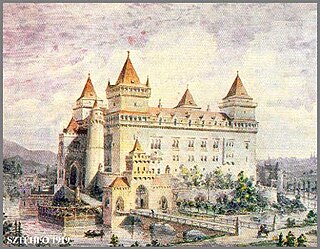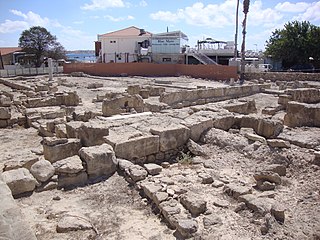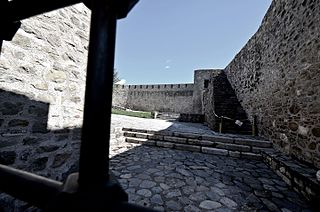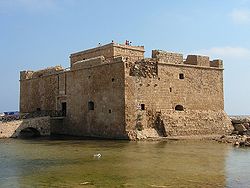
Tripoli is the largest city in northern Lebanon and the second-largest city in the country. Situated 81 km (50 mi) north of the capital Beirut, it is the capital of the North Governorate and the Tripoli District. Tripoli overlooks the eastern Mediterranean Sea, and it is the northernmost seaport in Lebanon. It holds a string of four small islands offshore. The Palm Islands were declared a protected area because of their status of haven for endangered loggerhead turtles, rare monk seals and migratory birds. Tripoli borders the city of El Mina, the port of the Tripoli District, which it is geographically conjoined with to form the greater Tripoli conurbation.

Janus was King of Cyprus and titular King of Armenian Cilicia and Jerusalem from 1398 to 1432.

Rumelihisarı or Boğazkesen Fortress is a medieval Ottoman fortress located in Istanbul, Turkey, on a series of hills on the European banks of the Bosphorus. The fortress also lends its name to the immediate neighborhood around it in the city's Sarıyer district.

Paphos is a coastal city in southwest Cyprus and the capital of Paphos District. In classical antiquity, two locations were called Paphos: Old Paphos, today known as Kouklia, and New Paphos.

Margat, also known as Marqab, is a castle near Baniyas, Syria, which was a Crusader fortress and one of the major strongholds of the Knights Hospitaller. It is located around 2 kilometres (1.2 mi) from the Mediterranean coast and approximately 6 kilometres (3.7 mi) south of Baniyas. The castle remained in a poor state of preservation until 2007 when some reconstruction and renovation began.

The Nimrod Fortress or Nimrod Castle is a castle built by the Ayyubids and hugely enlarged by the Mamluks, situated on the southern slopes of Mount Hermon, on a ridge rising about 800 m above sea level. It overlooks the Golan Heights and was built with the purpose of guarding a major access route to Damascus against armies coming from the west.

The Castle of Diósgyőr is a medieval castle in the historical town of Diósgyőr which is now part of the Northern Hungarian city Miskolc. The first Castle of Diósgyőr was built probably in the 12th century and was destroyed during the Mongol invasion (1241–42). The current, Gothic castle was built after the invasion and reached the peak of its importance during the reign of King Louis the Great (1342-1382). Later it became a wedding gift for the queens of Hungary, which it remained until the Ottoman invasion of Hungary in the 16th century. By the end of the 17th century it was already in ruins. Archaeological excavations were made from the 1960s. In 2014 the castle was restored, the rooms are furnished with Mediaeval-style furniture.

Selimiye Mosque, historically known as Cathedral of Saint Sophia or Ayasofya Mosque, is a former Christian cathedral converted into a mosque, located in North Nicosia. It has historically been the main mosque on the island of Cyprus. The Selimiye Mosque is housed in the largest and oldest surviving Gothic church in Cyprus possibly constructed on the site of an earlier Byzantine church.

Sidon's Sea Castle was built by the crusaders in the thirteenth century as a fortress of the holy land. It is one of the most prominent historical sites in the port city of Sidon, Lebanon.

Kyrenia Castle at the east end of the old harbour in Kyrenia is a 16th-century castle built by the Venetians over a previous Crusader fortification. Within its walls lies a twelfth-century chapel showing reused late Roman capitals, and the Shipwreck Museum.
The 1222 Cyprus earthquake occurred at about 06:15 UTC on 11 May. It had an estimated magnitude of 7.0–7.5 and triggered a paleotsunami that was recorded in Libya and Alexandria. The strongest shaking was felt in Nicosia, Limassol and Paphos. Many people died, although there are no estimates for the total number of casualties.

Yehi'am Fortress National Park is an Israeli national park in the western Upper Galilee on the grounds of Kibbutz Yehi'am, whose main attraction are the ruins of a hilltop castle.

Saranta Kolones is a ruined medieval fortress inside the Paphos Archaeological Park and it is located just north of the harbour of Paphos, on the island of Cyprus. It takes its name from the large number of granite columns that were found on the site and probably once formed part of the ancient agora. The Byzantine castle is believed to have been built at the end of the 7th century AD to protect the port and the city of Nea Pafos from Arab raids and later remodeled by the Lusignans. The Fortress had a three-metre thick wall with four huge corner towers and another four intermediary towers along the joining walls and moat surrounding the castle. Access was across a wooden bridge spanning the moat. The square courtyard measured 35 metres long by 35 metres wide, with a tower at each corner. The main entrance was through a fifth, horseshoe-shaped tower on the east side. Destroyed by an earthquake in 1222, the castle was subsequently abandoned. In modern times a series of excavations have taken place.

The Basilica of Panagia Limeniotissa(Greek: Βασιλική της Παναγίας Λιμενιώτισσας) is a ruined basilica in Paphos, Cyprus. It was built at the beginning of the 5th century and it is dedicated to "Our Lady of the Harbour".

The Castle of Mytilene, also Fortress of Mytilene, is located in Mytilene on the Greek island of Lesbos, North Aegean. It is maintained in good condition and is one of the largest castles in the Mediterranean covering an area of 60 acres. The first castle on the site may have been erected during the time of Justinian I. The 6th-century castle may have been built on top of an already existent fortress. In the late Middle ages, the castle was the residence of Francesco I Gattilusio and his successors, especially the tower known today as the Queen's Tower. There is also strong evidence that the original acropolis on the site may have included a sanctuary to Demeter, Kore and Cybele.

Bilhorod-Dnistrovskyi fortress or Akkerman fortress is a historical and architectural monument of the 13th-14th centuries. It is located in Bilhorod-Dnistrovskyi in the Odesa region of southwestern Ukraine, the historical Budjak.

The Trikala Castle is the Byzantine-era citadel of the city of Trikala in western Thessaly, Greece.
Amasra Fortress or Amasra Castle is located in the Amasra district of Bartın, on the Black Sea coast of Turkey. It was built by the Romans and later restored by the Byzantines, Genoese and Ottomans. It consists of two parts: Sormagir Castle and Zindan Castle. It was added to the Tentative List of World Heritage Sites by UNESCO in 2013.

















